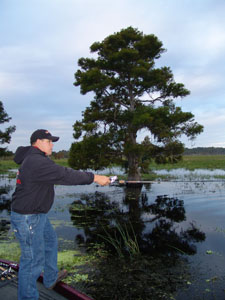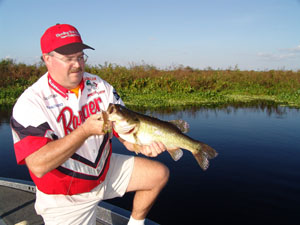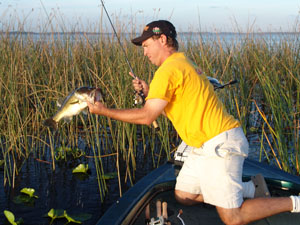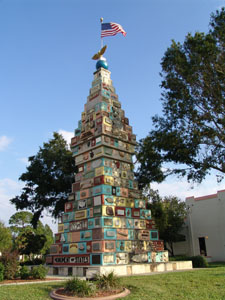Theme parks may have garnered Kissimmee its notoriety as the Vacation
Capital of the World, but, while Mickey and friends are a proud part
of the local climate, this Central Florida gem sparkles with many
facets.
Venture off the beaten path of Highway 192, and you'll find a
colorful tapestry of cultural and historic elements ranging from county
fairs, to Friday Night Rodeos to the annual Great Outdoor Days festival.
Each merits a visit, but the real treasure lies in the area's
amazing natural resources.

Photo by David Brown |
Osceola County is literally smattered with inviting bodies of water
covering more than 100,000 acres. A collection of creeks, rivers and
lakes create a lush environment that provides homes and forage for
abundant wildlife, including the largest concentration of nesting bald
eagles in the continental U.S.
Foremost in this
layout, the heralded Kissimmee Chain of Lakes starts just a few blocks
from Kissimmee's historic downtown district.
The north-to-south links include Lake Tohopekaliga (aka "Toho"),
Cypress Lake, Lake Hatchineha and Lake Kissimmee. The headwaters for
Florida's Everglades, these lakes connect via flood control canals,
which route water released by locks at Toho's south end through
the chain, out Lake Kissimmee via its namesake river and into Lake
Okeechobee.
The "Big O" played a significant role in Kissimmee's
past by linking the town to international shipping lanes via the Okeechobee
Waterway. During the late 1800's and early 1900's Downtown
Kissimmee was home to a major ship building operation, while the shores
of Toho became Central Florida's largest shipping port. Cattle,
citrus, sugar and other goods from around the state arrived here for
transoceanic voyages.
Lake Toho (18,810
acres) is the chain's second largest, behind
the 34,948-acre Kissimmee. Hatchineha and Cypress fill in the midsection
with 6,655 and 4,097 acres. Because of its metropolitan location
and convenient accessibility, Toho sees the most consistent traffic,
but remains a consistent producer.
Boats
often blow right through the center lakes, as canal channels traverse
only their outer edges. Those who stop are often rewarded with wide
open stretches and more cooperative fish. Nevertheless,
Kissimmee's vast, unspoiled habitat has a way of coaxing anglers
to launch and run straight down to the chain's lower link.
Like most Florida
lakes, the Kissimmee Chain's are shallow - averaging
around 5-6 feet. Recent bottom scrapings have dramatically improved
lake health by removing volumes of mucky buildup and exposing the natural
sand floor and prompting the expansion of native aquatic plant growth.
More vegetation equals more bass cover and that equals better fishing.

Georgia tournament
pro Scott Sills - photo by David Brown |
When Kissimmee
largemouths spawn between February and March, it's
time to go shallow. Georgia tournament pro Scott Sills grew up fishing
the chain and has found his best spring results by Texas-rigging a
worm or lizard (junebug or black/blue tail) with a 3/0-4/0 hook and 1/4-ounce
bullet weight and flipping it to bass beds visible in shoreline vegetation.
"This is power fishing," Sills said. "You make a
few casts and if you don't hook one, keep moving to the next
piece of cover until you find the bite."
Summer typically finds dense hydrilla weed beds filtering the water
to a clarity justifying bright lure colors. Topwater plugs (especially
double props) are a good bet, as are soft plastic frogs worked across
heavy vegetation.
Schooling bass will be chasing bait in open water early in the morning,
and then heading to thick, shady cover as the sun heats the lake. This
is the time to break out your heavy flipping stick and pester the fish
into reaction strikes.
Standing
vegetation makes a fine target, but warm winds pile dense mats of
floating weeds against shorelines - especially after
summer storms beat the lakes. Extending 20 yards or more from the "hard
line" of solid ground, these conglomerations offer prime opportunities
for flipping into open pockets or punching through a solid layer with
big Texas rigs. The intrusion often awakens slumbering giants who respond
aggressively to anything that disturbs their nap time.
Nose right up to the thickest mats and don't hesitate to probe
way back into the cheap seats. Just beware of inhospitable reptiles.
Alligators and cottonmouth water moccasins sunning themselves on weed
mats are most likely to flee long before you arrive. But surprising
one of the locals can make for a tense interlude in the old bass boat.

Tournament pro
Val Osinski - photo by David Brown |
Schooling activity continues into fall, but the fish typically hang
closer to the edges of vegetation. Lipless crankbaits, spinnerbaits,
topwaters and flukes will produce. As autumn yields to winter, most
bass bury into cover where flipping with ultra-slow presentations does
the trick. Look for intense feeding before a cold front and absolute
lockjaw on the backside.
Corking wild shiners
is a 24/7 no-brainer, but November through February yields tremendous
live bait action. Bigger is better, and a 10-inch bait won't offend a hungry largemouth. Rig shiners on 3/0-5/0
wide gap hooks and fish stout rods with 30-pound line. If you toss
a shiner into cover and he immediately leaps back out, you're
in the strike zone.
Given the influence
of Kissimmee's
flood control system, lake current can factor significantly in bass
behavior. Depending on how much water has been released, the flow
may or may not be immediately apparent. Area pro Terry Seagraves
suggests picking a fixed object like a stump or a grass point and
watching closely to see if water breaks around it.
Now, if hurricanes have an upside it is the promise of lake current.
Indeed, these tropical temper tantrums dump such concentrated volumes
of water in such short periods of time that the Kissimmee Chain frequently
bulges with hurricane water while anglers are carving Thanksgiving
turkeys.
Day-to-day, Sills
offers this advice: "For most people visiting
the area, I'd say concentrate on the heavy cover with flipping
sticks and you'll stand a good chance of connecting with a big
fish. But for numbers, try Rat-L-Traps, flukes and topwaters in the
open water around the edges of vegetation like Kissimmee grass or hydrilla
lines."
Seagraves adds: "If you don't know where to start, look
for points - whether that's hard points or grass points - and
you'll get something going. The bass will orient themselves to
spots where they can ambush prey."
Complementing superb bass action, the Kissimmee Chain also holds a
great speckled perch fishery, particularly at the ends of canals and
creeks. During spawning periods, shallow grass lines will hold loads
of specks. Bluegill, catfish and Florida gar round out the cast of
Kissimmee Chain regulars.
Next time you're eyeballing Central Florida for a vacation,
consider Kissimmee's well-rounded persona. Nothing wrong with
theme parks, but after you've shaken hands with a tuxedoed mouse,
you'll find that this town holds a magic kingdom of a whole other
kind. Here, the star attractions are always ready to put a bend in
your rod.

Monument
of States - Photo David Brown |
"Excursions"
Between fishing
trips, there's plenty to see in the Kissimmee/St.
Cloud area. Starting with Lakefront Park on Toho's north shore,
a family-friendly landscape welcomes picnics and offers plenty of room
for sports and relaxation. Casual anglers can wet a line from the seawall
or the wooden pier.
On the park's south end, the War Veteran's Monument is
dedicated to those lost during America's military conflicts.
Nearby, the Bataan-Corregidor Memorial honors the sacrifices of Americans
and Filipinos during WWII. And, at the corner of Johnston St. and Monument
Ave., the Monument of States assembles an eclectic blend of stones,
bones, meteors and petrified wood from every state and 20 foreign countries.
Historic Downtown
Kissimmee includes the Osceola County Courthouse (Florida's oldest courthouse still in daily use); Makinson's
Hardware (opened in 1884, it's the state's oldest operating
hardware store) and First Presbyterian Church (Kissimmee's oldest
church, dedicated in 1886) featuring Steamboat Gothic architecture.
Strolling through this pedestrian-friendly area is a great way to stumble
across nuggets of Osceola County history - often through wall
murals depicting various scenes of early settlement days.
Other sites to visit include:
- Forever Florida: A working cattle ranch and nature
preserve centered on the heritage of the Florida Cracker Cowboy.
Nature tours by horseback or elevated cracker coach often provide
candid glimpses of wild turkeys, whitetail deer and other native
critters. (407-957-9794)
- Gatorland
Zoo: View all sizes of Florida swamp dragons from a safe
distance. Also includes ecotours, wildlife exhibits and daily gator
shows. (407-855-5496)
- Osceola
County Historical Society & Pioneer Museum: An authentic
1898 "Cracker House," pole-barn, blacksmith shop, sugar cane mill
and artifact museum offer insight into the daily life of the county's
early settlers. (407-396-8644)
- Boggy
Creek Airboat Rides: Skim across shoreline shallows and
experience Kissimmee's wild habitat from a unique perspective. (407-344-9550)
- David A. Brown
"VISITOR
INFORMATION"
If you're
flying into the area, Orlando International Airport is less than
an hour from Downtown Kissimmee. The main driving corridor, U.S.
Highway 192 runs right into Disney theme park entrances on its west
end, and provides easy access to a broad range of lodging, dining
and entertainment as it continues east through town and across to
St. Cloud. The convergence of Interstate 4, Highways 441 and 17/92,
and the Florida Turnpike facilitates transit to and from anywhere
in Osceola County.
MARINAS/FISH CAMPS
Big Lake Toho Marina (407-846-2124)
Cypress Lake Fish Camp (407-908-8309)
Port Hatchineha Marina (863-439-1686)
Camp Lester (between Hatchineha and Kissimmee, 863-696-1123)
Camp Mack River Resort (between Hatchineha and Kissimmee, 863-696-1108)
Grape Hammock Fish Camp (Lake Kissimmee, 863-692-1500)
Thomas Landing RV and Fish Camp, Inc. (Lake Kissimmee, 863-692-1121)
For additional
information, contact the Kissimmee-St. Cloud Convention and Visitor's
Bureau at (800) 831-1844 or visit www.floridakiss.com.
About
the author: David A. Brown is an award-winning wordsmith with more
than 20 years of professional writing experience. Formally
educated and trained in traditional journalism, David has honed
his natural writing skills to laser-sharpness and mastered the
elements of editing and proofreading. For
more information on David A. Brown, visit his website TightWords.com

